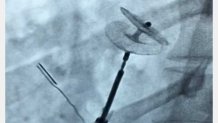An Argyle family is counting their blessings after their daughter suffered a stroke at just 18 years old.
The cause of the stroke was due to an opening in her heart, which has led the teen on a journey of survival and enlightenment on heart health.
FROM GRADUATION TO STROKE
Samantha “Sam” Gladys graduated high school last May and by fall, was already juggling a very busy routine while continuing her studies at the University of North Texas.
Get DFW local news, weather forecasts and entertainment stories to your inbox. Sign up for NBC DFW newsletters.
“As a normal college student, I would wake up in the mornings and go workout,” she told NBC 5. “I tried to get a routine of working out every morning, then go to class; then after class do some studying before I headed to work.”
She even took up extra shifts at work – but it was nothing to the former cheerleader and soccer player, who was very athletic and competitive in high school.

But suddenly in October, something happened that would change her life forever.
Local
The latest news from around North Texas.
While stopping by her parents' house in Argyle for visit, she said she felt a wave of dizziness take over her body.
“I was saying bye to my dad. Then I was walking down the stairs and I just got really lightheaded. Something was different about this,” Gladys remembered. “Normally when I get lightheaded, I sit down and kind of let it pass, and then it was like a sharp pain in my head. I was really confused.”
The pain in her head got so bad, she tried to scream and explain to her dad what was happening to her. But her words were slurring.
“My whole body was vibrating. Like, I can't feel anything. It's just like vibrating,” Gladys said. "It was weird because I couldn't say anything or do anything with my body, but my whole, like my brain was completely, like, functioning. I was like, I understand everything that's happening. But I felt helpless."
She started throwing up uncontrollably and her parents rushed her to an emergency room.
After several tests, she found out it was a stroke.
“My parents are both so surprised. They're like, we would never have thought about this being a stroke,” Gladys said.
Then immediately following more tests, doctors told found the cause of it was a small opening in her heart.
A UNIQUE CONDITION
The Gladys family was quickly connected to cardiologist Dr. Vijay Kalaria, who works with Texas Health in Fort Worth, for treatment. He said she was one of the youngest stroke patients he had taken care of.
“And from that, for her to make a complete and remarkable recovery is just so gratifying,” he said.
He said Gladys had a condition called Patent Foramen Ovale, or PFO, which led to her stroke. Specifically, it’s a small open flap between the two upper chambers of the heart that can form in some people.
Kalaria said normally that flap closes after birth in most people, but it didn't in Gladys.
“Everyone's born with the foramen ovale. It's a small location between the two upper chambers of your heart where there is a flap. That flap, when it pops open, allows blood from the mother's uterus – oxygenated blood – to give oxygen to the fetus while they are in utero,” Kalaria explained. “After birth, with the first cry, that flap shuts down, because the pressure on the left side of the heart increases. And over a few days to a few weeks, it fuses. in certain patient populations, that flap does not fuse.”
That’s what happened to Gladys, who continued to unknowingly live with that opening in her heart with no issues for 18 years. Eventually, a clot formed in her body and was able to travel between the two chambers of the heart due to that flap allowing the passage to take place.
“It can pop open and serve as a potential conduit for debris or clot material to go from the right side of the heart to the left side of the heart,” said Kalaria.
Gladys said doctors told her a recent bout with COVID-19 last year or stress could have started the issues that lead to the clot, and eventually the stroke. But the exact cause remains unclear.
What was known was how to treat Sam.
Kalaria performed a surgery that required no incisions in her chest. Instead, he worked through a vein in her groin and was able to place a device in between the two chambers of her heart that sealed the hole. It’s a procedure he said he has performed countless times over the last 25 years.

Kalaria said PFO is more common in the general population than many realize, but only rarely will it lead to life-threatening strokes. That’s why he said screening for such a condition can be complicated.
“It's really tricky. I would not recommend screening because 15% to 20% of the general population has PFO, so screening for it would lead to many people worrying about it and getting unnecessary treatment,” he said. “But in a patient who is especially in the younger age groups – if you have a stroke for which there is no identifiable cause and if your caretaking doctors are not looking into this specific cause, then one should certainly bring it to their attention. The medical community is warming up to this diagnosis.”
He said it's important for families and doctors who see strokes in younger patients to keep this condition in mind.
"That's the best part of my job, it never gets boring. And we are still learning a lot about the heart,” Kalaria said. “Cardiology is probably one of the most evidence-based specialties [in medicine]. We have a lot of research and a lot of development but we still have a ways to go in identifying these patients early on."
Gladys said her faith and determination helped her to cope with the experience.
"So much has already happened to me. I was like, 'Why me?' Like I'm so active and healthy. And I'm I just go and do my stuff. I work hard. I've never had any health issues. And then I find out that there's a hole in my heart. And I'm just confused. Like, 'Why me? Why would this happen?'" she said.

Now, Gladys is getting involved in American Heart Association events for heart month, all while continuing her studies at UNT. She’s currently on medication as she continues to recover from her stroke and procedure.
"It just makes me more aware of what I'm doing, how I'm acting, stuff I'm putting in my body,” she said. “Take care of your body. If something doesn't feel right, do something about it. You need to listen to your body and know what it's telling you because if it doesn't feel right, it's probably something wrong.”



